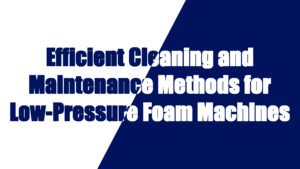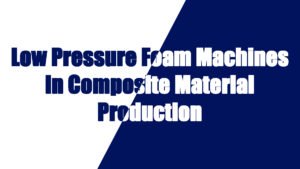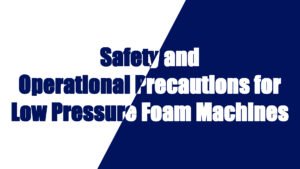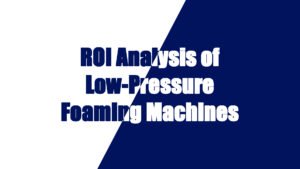Polyurethane foaming equipment plays a critical role in modern industrial production, widely used in industries such as furniture, automotive, construction, packaging, and more. The adaptability of this equipment to multiple raw materials and its ability to adjust foam density according to different needs significantly contribute to the efficiency and flexibility of production processes. As technology continues to advance, polyurethane foaming equipment has become more versatile, capable of meeting a wide range of production requirements. Below is an in-depth analysis of the raw material compatibility and foam density adjustment capabilities of polyurethane foaming equipment.
Raw Material Compatibility of Polyurethane Foaming Equipment
Modern polyurethane foaming equipment is designed to accommodate various raw materials, providing significant flexibility for production. The equipment uses precision raw material control systems to mix and react different chemical substances, ensuring high efficiency and stability throughout the foaming process.
Isocyanate and Polyol Ratio Adjustment
The primary raw materials for polyurethane foam are isocyanates (MDI or TDI) and polyols. The ratio of these two materials determines the final characteristics of the foam. Modern foaming equipment is equipped with automated ratio control systems, which allow precise adjustment of the isocyanate to polyol ratio. By fine-tuning this ratio, the equipment can produce foams with varying hardness, elasticity, strength, and other performance characteristics, tailored to different product requirements.
Temperature Control and Raw Material Reaction
Temperature is a crucial factor that affects the reaction rate and foam quality during polyurethane foaming. Foaming equipment typically features temperature control systems that allow precise regulation of the raw material temperatures. By adjusting the reaction temperature, the equipment can control the reaction rate, improving the uniformity and stability of the foam. For example, lower temperatures can help improve foam consistency and product stability during certain manufacturing processes.
Compatibility with Different Blowing Agents and Additives
In addition to the basic components of isocyanates and polyols, equipment can accommodate various blowing agents, catalysts, plasticizers, stabilizers, and other chemical additives. For example, in seating production where higher comfort is required, plasticizers can be added to increase foam softness; in the construction industry, specialized blowing agents can be used to enhance thermal insulation performance. The equipment can precisely control the amount of these additives to meet specific product needs.
Compatibility with Diverse Raw Materials
As market demands diversify, polyurethane foaming equipment can handle not only traditional MDI and TDI materials but also modified or specialty raw materials, such as water-based blowing agents, renewable polyols, and low environmental impact blowing agents. The equipment’s high compatibility makes it suitable for use in a variety of emerging industries.
Foam Density Adjustment in Polyurethane Foaming Equipment
Foam density is a key parameter in polyurethane foam materials, directly influencing the foam’s physical properties, such as strength, elasticity, insulation performance, and more. Polyurethane foaming equipment is capable of precisely adjusting foam density, ensuring that it meets diverse requirements across industries.
Methods of Density Adjustment
Foam density adjustment is typically achieved by altering the ratio of raw materials, the amount of blowing agent, the reaction temperature, and the reaction time. For example, by increasing the proportion of blowing agents, the equipment can produce low-density foams, suitable for packaging, insulation, and other applications requiring lightweight materials. Conversely, reducing the amount of blowing agent or increasing the density of the raw materials will yield high-density foams used in products that require higher strength or better thermal stability.
Precision in Density Control
Modern polyurethane foaming equipment is equipped with high-precision control systems that monitor various parameters during production, such as raw material flow, mixing ratios, temperature, and pressure. These data points help the equipment precisely adjust foam density, ensuring consistent foam quality across batches. This precision in density control helps ensure that each foam batch meets specific product requirements, reducing scrap rates.
Applications of Different Density Foams
Polyurethane foams are produced in various densities to meet the specific needs of different applications. Low-density foams are commonly used in Verpackung, Isolierung, and soundproofing, while medium-density foams are used in Möbel and bedding. High-density foams are found in automotive seats, building insulation panels, and other products that require higher strength and durability. The flexibility of modern equipment allows manufacturers to adjust the foam density to suit the specific demands of various industries.
Multi-Density Foam Production
Some advanced equipment allows for the production of multi-density foams, where different parts of the foam have different densities. For example, in mattress production, different parts of the foam may have varying densities to achieve an ideal balance between comfort and support. The equipment’s ability to control foam density in different zones during production ensures that the final product meets the desired specifications.
Flexibility and Industry Adaptability of Polyurethane Foaming Equipment
The high flexibility of polyurethane foaming equipment makes it suitable for a wide range of industrial applications. Whether it’s low-pressure foaming, high-pressure foaming, or special processes, the equipment can be adjusted to meet different production requirements, producing foams with varying characteristics.
Support for Various Foaming Methods
Modern polyurethane foaming equipment supports different foaming processes, such as low-pressure foaming, high-pressure foaming, and mold-free foaming. High-pressure foaming is typically used to produce high-density, high-strength foams for applications like construction insulation materials and automotive seating. Low-pressure foaming, on the other hand, is ideal for producing lightweight, flexible foams used in furniture cushions and mattresses.
Adaptability to Different Products
Different industries have varying requirements for polyurethane foams. For instance, in the automotive industry, components like seats, interior parts, and door linings require foams with different elasticity, hardness, and durability. Polyurethane foaming equipment can adjust the raw material ratios, foam density, temperature, and other parameters to meet the specific needs of different products.
Improving Production Efficiency and Reducing Costs
Modern polyurethane foaming equipment is designed to enhance production efficiency. With automated control systems and intelligent monitoring, the equipment can precisely adjust each step of the production process, reducing human error and improving overall efficiency. Additionally, by optimizing raw material use and energy consumption, the equipment helps reduce production costs.
Maintenance and Optimization of Polyurethane Foaming Equipment
To ensure the efficient operation and stable performance of polyurethane foaming equipment, regular maintenance and optimization are crucial. By routinely checking key components, replacing worn parts, and optimizing settings, manufacturers can reduce equipment failure rates and lower long-term maintenance costs.
Maintenance and Care
Regular maintenance of polyurethane foaming equipment includes inspecting the raw material system, hydraulic system, electrical system, and more. Cleaning the equipment, lubricating mechanical parts, and replacing aging seals help extend the equipment’s service life. Proper maintenance reduces the likelihood of breakdowns and improves the stability of production.
Intelligent Maintenance Management
With the advancement of IoT technology, many modern polyurethane foaming machines are equipped with intelligent monitoring systems. These systems provide real-time feedback on the status of the equipment, monitoring key indicators such as temperature, pressure, and flow. These systems can help companies identify potential problems before they lead to equipment failure, allowing for preventive measures and reducing downtime.
Polyurethane foaming equipment’s adaptability to multiple raw materials and its ability to adjust foam density make it an invaluable tool across many industries. From construction and furniture to automotive applications, the equipment’s flexibility and precise control allow it to produce foams with a wide range of characteristics, meeting specific product requirements. As technology continues to advance, the equipment’s increased automation and smart capabilities provide significant benefits in terms of production efficiency and cost reduction. By adjusting foam density and raw material ratios, manufacturers can produce high-quality polyurethane foam products that meet market demands and support business growth.




































